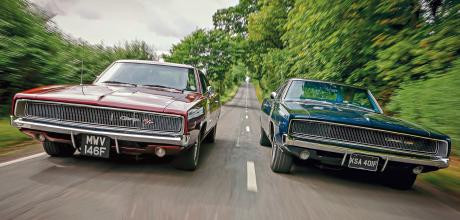Dodge Charger Duo 1968 440 R/T and 1968 small-block V8
Seeing one 1968 Dodge Charger in the Scottish countryside is unusual enough, so two of them together certainly gets our attention. Especially when they’re such different cars and different stories.
Words: Nigel Boothman
Photography: Lewis Houghton
DUAL CHARGER SHOWDOWN FROM MILD TO WILD
Ever tried to overtake a ’68 Charger on a British B-road… while driving another ’68 Charger? There isn’t a lot of wiggle room. You become conscious of the steering, which is designed to make an easy job of manoeuvring a large car at lower speeds, but not really suited to placing it with inch-perfect accuracy. Trees and hedges bear down from one side and the graceful flanks of the other car seem close enough to swap paint − but if we can just hold it for a moment or two – yes, our photographer has his shot.
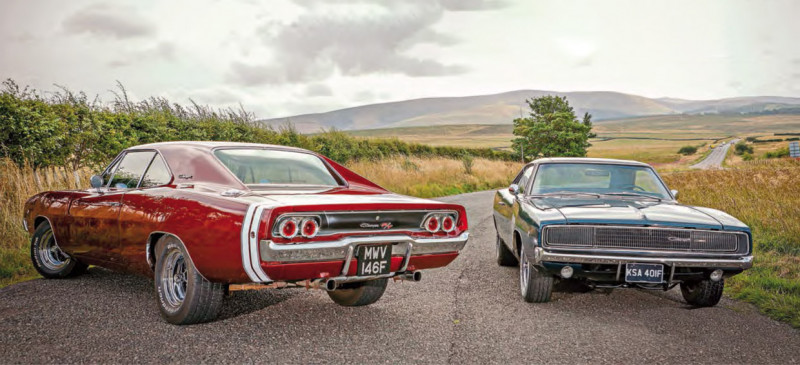
One of the things that’s both a pleasure and a pain about owning American classics in the UK is that they’re just not built for our conditions. It’s a pleasure because it makes American cars stand out so much from their European counterparts, which used to be built to a different scale. In this age of hulking great SUVs, there’s less of a difference, but attend a classic car show and you still feel like you’ve brought a Dinky toy to a Matchbox convention. It can be a pain when the parking spaces are too small, the lanes are too narrow and the turns are too tight, but we manage to live with it.
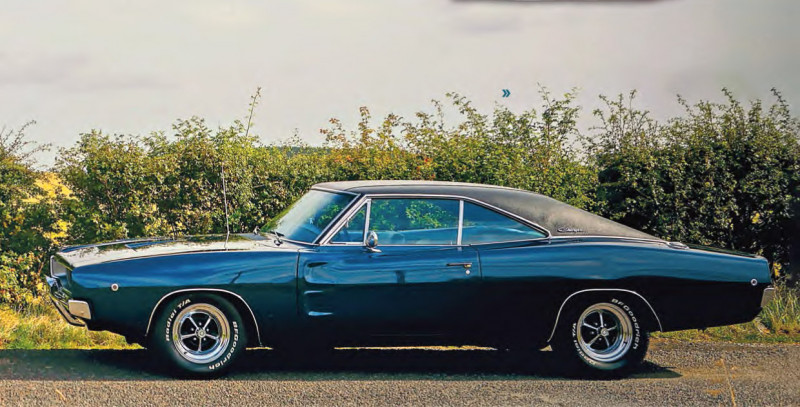
We tend to do it in different ways, though, and these two Chargers are examples of that. One of them is a small-block car, preferred because it’s easy to drive, usable and by the standard of V8 muscle cars, pretty economical. The other is a genuine 440 R/T and represents the owner’s ideal muscle machine – not racespec or extreme, but a potent brute that’s fairly civilised on a light throttle and pretty raucous with your foot down. If you can afford the petrol.
“IT WAS THAT STUNNING SHAPE WHICH CHANGED THE CHARGER’S FORTUNES. LOOK AT THE SALES FIGURES: 30,000 IN 1966; 16,000 IN 1967, THEN 96,000 IN 1968. JACKPOT!”
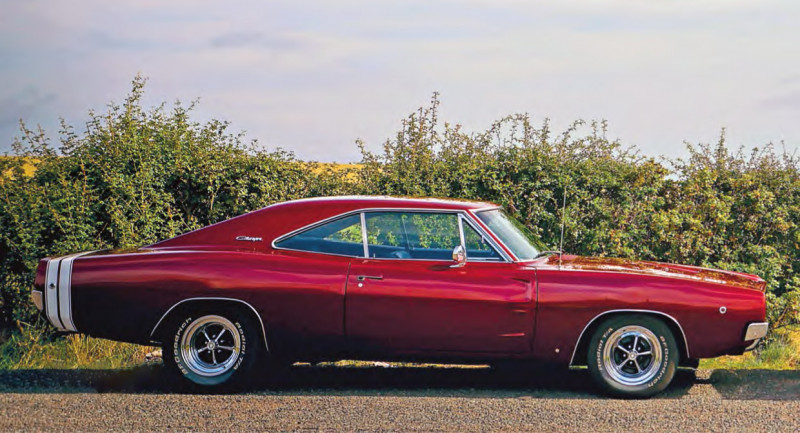
We’re here in the leafy lanes south of Edinburgh to meet the owners and hear their stories, and maybe even to decide which car we’d go for if we had the choice. The 1968 to ’70 Charger wasn’t the first Dodge Charger, as most of you will know – the model was launched in 1966 as a big fastback two-door on the Coronet chassis and running gear. It was a handsome car, but not an all-time great, though some of the key features were there, most notably the full-width front grille that concealed the headlamps. See ‘In charge of styling’ on page 34 for more history.
The second-series Charger got an early starring role in Bullitt, which must have helped, but one movie doesn’t make a success of any new car. In fact, it was that stunning shape which changed the Charger’s fortunes. Look at the sales figures: 30,000 in 1966; 16,000 in 1967, then 96,000 in 1968. Jackpot! Now, 55 years later, owners like Ali Wilson and Brian Preston are still drawn to the perfection of the original ’68 model.
Always fancied one
“I always fancied an American car and a ’68 Charger was in the back of my mind for ages,” says Ali, owner of the wine-red 440 R/T. “I probably saw The Dukes of Hazzard before I saw Bullitt but, to be honest, neither of those was key – it’s just the shape of the car itself I liked. So when I could finally afford it in 2016, I went on American eBay and snapped this one up without much competition. I think there was only one other bidder.” The car was in Indiana, which is quite a way down the road from Ali’s home in Peebles, in the Scottish Borders.
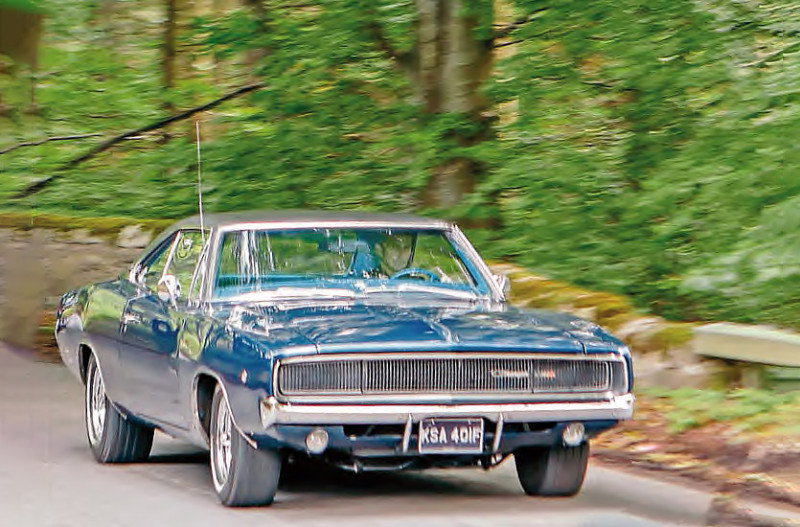
“The owner was the president of a thermoplastics company,” says Ali. “I found myself googling his name, just to make sure he was who he appeared to be because I had to send him a large chunk of money; my bank manager wanted to know he was for real. But I spoke to him and to his bank on the phone, so it all checked out and we did the deal. The car was shipped to New York, came on the boat to Liverpool and from there to my front door.” Ali says the car was sold as a “nine-out-of-10 restoration”, in other words, not perfect, but very nice.
“And I think that was right,” he says. “I was able to use it for a couple of years until I was on my way up to Knockhill Racing Circuit one day, and the oil filter seal failed. It dumped all the oil on the Forth Road Bridge, but I didn’t notice what had happened in time, and the damage was done. So the engine had to be rebuilt.” Here’s where things started to go wrong.
Those who attempted the first build, to a tuned 500cu in capacity, produced something that didn’t really work. After a lot of grief, Ali enlisted the help of Dave Billadeau, a name familiar to many UK Mopar fans. Dave builds tarmacripping race motors, so returning the Charger’s engine to healthy, standard 440 R/T specification wasn’t a stretch, and it was reunited with the car in the spring of 2022.
“When I bought it, I knew the engine wasn’t original to the car, and I was told it was probably a 1972 R/T unit,” explains Ali. “During the rebuild process, it turned out the engine was actually from 1978 and probably started life in a motorhome or a Dodge Warlock pick-up. But it’s still a 440, so it can be rebuilt to R/T specification and end up just as the original one would have been.”
That means a rating of about 365hp and plenty of torque, in this case feeding through the familiar Torqueflite three-speed transmission. The R/T was the high-performance Charger, and the extra $466 over the $3014 list price bought you not only the 440-inch Magnum V8, but also that auto transmission, plus dual exhausts, heavy-duty brakes, a handling package and racing stripes around the tail. Stiffer damping, different spring and torsion-bar rates and a thicker sway bar probably covers the handling package, and it does offer a little more body control, though Ali is not convinced by the heavy-duty brakes. “It doesn’t like stopping; they’re still un-servo’d drums all round,” he says. “It’s something I’m always aware of, especially on wet roads or poor surfaces, but the steering is a delight now I’ve fitted a Borgeson ‘Firm Feel’ steering box; the original box was beyond repair and had more of a ‘marshmallow’ feel.” So Ali is able to enjoy a fighting-fit 440 R/T at last. What a shame the return to regular use coincided with super unleaded hitting £2 a litre, but if it’s a more economical day out you’re after, then maybe you need a small-block Charger…
Go small, or go home!
Brian Preston’s gorgeous blue example is one of perhaps 60% of the 1968 production which was ordered with the 318cu in, two-barrel V8. You could go smaller and order a Charger with a straight six, but hardly anyone did. These were fairly affordable cars, but certainly not in the budget category – if you really had to spend less on a sporty two-door Dodge, a Dart GT was $400 cheaper than a Charger.
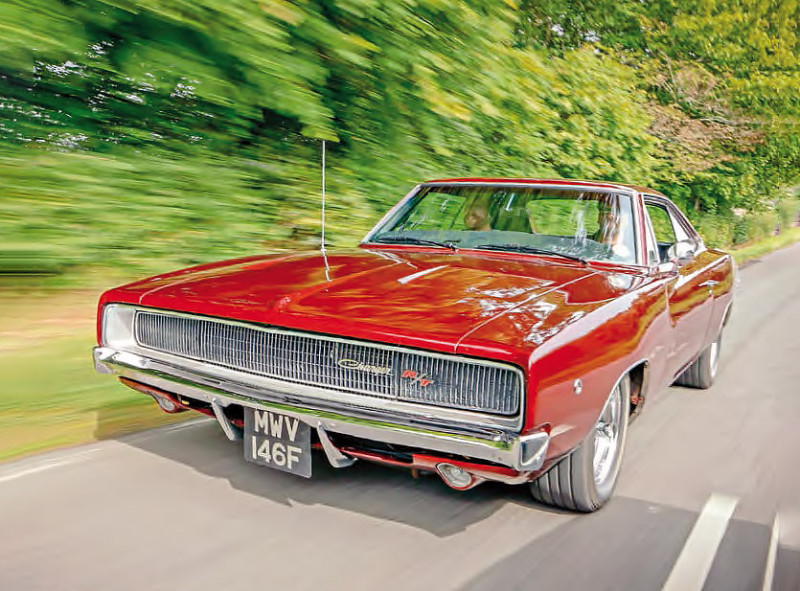
Brian wasn’t a Charger convert thanks to The Dukes of Hazzard either, though he saw the appeal of Bullitt. It wasn’t a huge influence though, until Brian found himself on a film set with the ’68 Mustang fastback he’d owned since the Nineties. “It was a part of a movie called Cloud Atlas that was filmed in Scotland, and they needed a few American cars. There was a guy with a triple-black Charger and he asked me to drive it for one sequence… I thought it was such a cool car.” That was 10 years ago, but it set Brian on the path towards owning one. Yet somehow, previous attempts to acquire a Charger came to nothing.
“I tried three times over the years to buy one and it always fell through,” he says. “One attempt ended up with me buying a ’71 Mustang Mach 1 Cobra Jet, but when I later sold that, I was in a position to look for a Charger again. Around 2019 I looked online at cars in the US and identified six I could go and see in California, so we planned to make a holiday of it, but then Covid stopped all that.” What could you do from home? Place a ‘wanted’ ad, so Brian did just that. His first choice would indeed be a triple-black car, black paint, roof and interior, but he always knew he wanted a small-block V8 rather than a 440. The nicest of the cars he was offered was a blue ’68 with a black vinyl roof and the 318cu in V8.
“It came from a guy called Adrian Glen in Suffolk,” says Brian. “He had bought it from a dealership in the Netherlands, who in turn imported it from Alabama. It was sold new in Georgia. Adrian hadn’t used it much, but he’d worked on it a bit, doing just the things I would have wanted done: suspension from a big-block car, power brakes, a new crankshaft oil seal and general maintenance. It had never been restored or even welded and the numbers matched. It had all its original paperwork, which is really rare for cars that have come in from the States. So I have the build sheet, dealer invoices and all of that.” Since getting hold of the car in 2020, Brian has improved it further with a transmission rebuild, new valve-stem oil seals and an interior tidy-up: a new carpet, a bit of detailing and some fixing of scruffy buttons and dash controls. Then, once lockdown rules allowed it, the car came out to play and Brian reckons it’s done 3000 miles a year since, including a tour of several hundred miles around the Solway Firth in south-west Scotland.
“The small-block pushes it along fine,” he says, “and it gets better mileage than my Mustang. I get 20mpg from it, maybe more on a run, and that’s totally realistic for me. I’m happy to take it anywhere. It’ll cruise at 70mph all day and I think the brakes − drums all round, but with a booster – stop it really well.”
Maybe the lesser weight over the front end compared with a 440 helps it to shed speed more calmly, but as Brian says, it’s still a 1968 car so you have to be aware of the limitations. Brian’s other classics include a 1953 Ford F-series pick-up with a Mustang V8 but still the beam front axle, while the Mustang now has a lively crate motor. So by comparison, the Dodge is relaxed and easy to live with.
“We have a modern BMW, but I rarely use it,” he says. “The Dodge is much nicer.” It’s been fun to hang around with these two cars and their owners as, even out in the Scottish countryside, they stop the traffic. Everyone from dog-walkers to cyclists to passing motorists stops and has a chat as we finish off our photos, something that Brian and Ali are clearly used to. Maybe it’s because there are two of the same model, or maybe it’s because the ’68 Charger is such an eye-catching shape – not everyone seems to know what they are, but people can’t stop looking at them and taking photos.
That just leaves us to make the agonising choice – which one are we taking home? We worked out the difference in fuel costs between the two cars and it does make you wince, but Classic American readers are used to the sacrifices necessary to drive big V8s, so let’s put that to one side. It’s purely personal, but the colour scheme and particularly the history and originality of Brian’s small-block car are persuasive. Still, as we drove away, we knew we’d be dreaming of the days when petrol was a minor expense. Then, have no doubt, we’d be leaving black lines on the tarmac in a full-fat 440 R/T. But the saving grace is that whichever car you chose you’d still be in one of the best-looking machines ever built. And no amount of economic turmoil can change that.
In charge of styling
In the Sixties, Chrysler’s different marques were still styled in brand studios, so Dodge had a different styling team from Plymouth, even if both of them had to build on the same B-body platform and share running gear. This led to rivalry, not a little secrecy and a great deal of creativity. Elwood P Engel was the overall man in charge, director of styling at Chrysler Corporation, and his team in the Dodge Exterior Studio included chief designer Bill Brownlie, Harvey Winn, Richard Sias, Diran Yazejian, Charles Mitchell and Frank Ruff. Richard Sias kicked off the shape for the ’68 Charger – unwittingly – when he created an exotic-looking 1/10th scale concept, a streamlined coupe shape with something of the ‘double diamond’ side profile. B-body development manager Frank Ruff and Brownlie’s second-in-command, Charles Mitchell, wondered as early as 1964 if Sias’s model could be modified into something that would sit on the B-body platform.
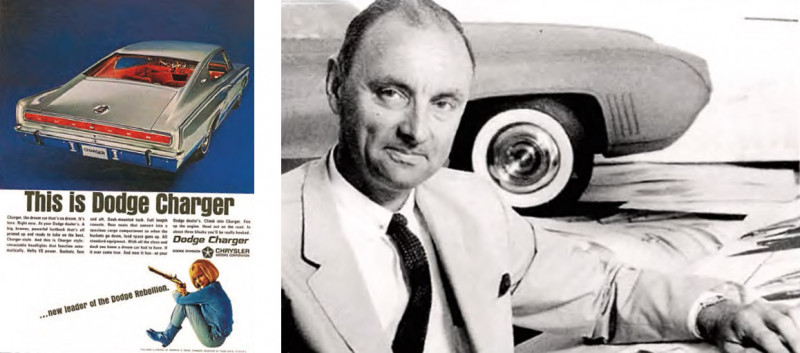
Sias requested a couple of talented clay sculptors, Don Kloka and Jim Romeo, to give him a hand, and even got Mitchell to agree to screening off an area of the studio where they could work without product planners spotting what they were up to. They created a full-size clay buck and the ’68 Charger was born. Or was it?
It was an unorthodox way of doing things. The idea was usually to evolve the previous design so customers could recognise a family resemblance and tell new from old. Not doing so made Bill Brownlie nervous. Also, his team were enjoying themselves too much with the Charger project and missing deadlines for other work, so as he left for a two-week trip to Europe, he ordered work on the new Charger to cease. When he returned to find the Charger model almost finished, he was fuming when Elwood Engel walked in, put an arm around Brownlie’s shoulder and said: “Now that’s what a car should look like!”
Elwood Engel. First generation Charger. Owners Ali and Brian, with writer Nigel Boothman on the shoot. Whichever you choose, the ’68 Charger is a great-looking car!
Car covers 3000 miles a year. Charger’s buildsheet. Charger came with much of its original paperwork.
Below: Dodge benefited from a transmission rebuild and new valve-stem oil seals.
Stock-looking interior. Torqueflite too! Brian Preston.318 motor gets 20mpg according to Brian. Good idea: extra gauges. Bullet-proof Torqueflite auto ’box. Billadeau-built 440. Grant GT aftermarket steering wheel. Tic Toc tach. Drums all round make for lively braking. “Always fancied one,” says Ali.


